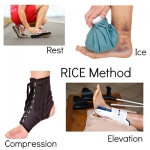What is a Sprain?
In this blog, we will take a look at what rolling your ankle really means. Ankle sprains are one of the most common injuries in the lower leg. This happens when a ligament, the tissue that connects your bones to other bones, is stretched beyond its normal capacity. Something as simple as stepping on a rock while running or slipping down a step can all cause an ankle sprain. While it is quite possible to fracture your ankle from these activities, it typically takes much more of a high impact force to break a bone than sprain a ligament.
How Do I Know It’s a Sprain?
The easiest way to determine if there is a fracture is with a diagnostic studies, such as x-rays. Sprains often exhibit with point tenderness over the affected area, discomfort during weight bearing, bruising, and swelling in the foot or ankle. In some more extreme cases, a ‘pop’ may be felt or heard during the injury itself. If this happens, you should follow up with a doctor for an evaluation.
Lateral Ankle Sprain
(Inversion Ankle Sprain)
 This is by far the most common type of ankle sprain, and happens when you roll your foot inwards, stretching the ligaments on the outside of your ankle. Typically, the ligaments of the ankle are injured when you turn your foot inwards with force. Common ways for this to happen are when you step off a curb funny with your toes turned inward, stepping on someone’s foot when landing from a jump (during sports), or slipping off of a step.
This is by far the most common type of ankle sprain, and happens when you roll your foot inwards, stretching the ligaments on the outside of your ankle. Typically, the ligaments of the ankle are injured when you turn your foot inwards with force. Common ways for this to happen are when you step off a curb funny with your toes turned inward, stepping on someone’s foot when landing from a jump (during sports), or slipping off of a step.
High Ankle Sprain
(Syndesmotic Ankle Sprain)
 The second most common ankle sprain occurs mostly in the athletic community. This is thought to be due to the nature of these injuries which are more commonly seen in those with high intensity lifestyles. This type of ankle sprain is caused by an outward twisting of the foot and ankle. Common ways to sprain this ligament involve side-to-side running, starting and stopping your feet repetitively, or turning while in motion.
The second most common ankle sprain occurs mostly in the athletic community. This is thought to be due to the nature of these injuries which are more commonly seen in those with high intensity lifestyles. This type of ankle sprain is caused by an outward twisting of the foot and ankle. Common ways to sprain this ligament involve side-to-side running, starting and stopping your feet repetitively, or turning while in motion.
Medial Ankle Sprain
(Eversion Ankle Sprain)
 The medial ligaments of the ankle forms a wide, thick protective bundle over the ankle joint. This ligament (the deltoid ligament) is structurally strong, and only a very powerful force can cause damage to this area. Gymnasts and ballet dancers are more susceptible to injury due to the position at which the feet are placed during high impact landing or rotation.
The medial ligaments of the ankle forms a wide, thick protective bundle over the ankle joint. This ligament (the deltoid ligament) is structurally strong, and only a very powerful force can cause damage to this area. Gymnasts and ballet dancers are more susceptible to injury due to the position at which the feet are placed during high impact landing or rotation.
Can I Treat This at Home?
Of course!
 There are several ways to get you up and at ’em in no time at all! Just like with other injuries, just remember RICE!
There are several ways to get you up and at ’em in no time at all! Just like with other injuries, just remember RICE!
R: Rest your ankle
I: Ice the ankle for 20 minutes every hour to assist in swelling control.
C: Compression with an ace bandage or tight fitting tall sock.
E: Elevation of the foot ankle ankle above the level of the heart with help improve circulation and inflammation.
When Should I See the Doctor?
Most sprains heal well with home treatment, exercising the ankle, over the counter anti-inflammatory medications, and wearing supportive shoes. If there is pain or weakness in the ankle after several weeks, it might be time for a check up.
By: Riki Duncan, MA. Ed, ATC, LAT
Sources:
http://www.sportsinjuryclinic.net/sport-injuries/ankle-achilles-shin-pain/eversion-ankle-sprain
http://www.footvitals.com/ankle/high-ankle-sprain.html
http://www.webmd.com/pain-management/ankle-sprains
https://www.podiatrytoday.com/essential-insights-treating-medial-ankle-sprains

